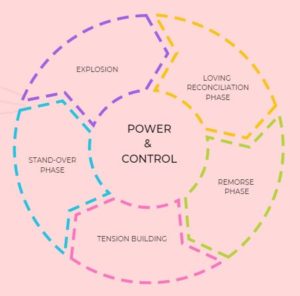While not an exhaustive list, we hope the resources below can provide you with a foundation on establishing the definition of domestic violence as well as crafting some ideas of what abuse might look like for folks experiencing it.
What is DOMESTIC VIOLENCE?
Domestic violence (DV) is defined not by individual acts of violence, but by a PATTERN OF INTENTIONAL BEHAVIOR used by one person to MAINTAIN POWER AND CONTROL over another. Domestic violence occurs between people in relationships. This includes, but is not limited to current or former partners, between the elderly and their caretakers, parents, children and/or relatives, sex workers and their pimps or clients, as well as survivors of stalking or trafficking. DV can to anyone regardless of ethnic or cultural background, socioeconomic status, education level, religion, gender identity, sexual orientation, ability or age.
Domestic violence is NOT CAUSED by illness (mental or physical), genetics, alcohol or drugs, anger, stress, behavior of the survivor, or relationship problems. While these factors may exacerbate abusive behaviors and/or increase lethality, they do not CAUSE the abuse. Domestic violence is a choice made by the person using abuse to sustain power and control over their partner.
What does DOMESTIC VIOLENCE LOOK LIKE?
Although commonly presented as such by the media, domestic violence does not always take the form of severe physical abuse. Many times, survivors think that just because their partner is not hitting them, that they are not a survivor of domestic violence. By knowing the many tactics abusive people use to gain control of their partner(s), it may assist you in understanding the numerous ways domestic violence may show up in an abusive relationship.
- Forms of Abuse – These lists offer up examples of different types of violence.
- Power & Control Wheel/ Expanded Power & Control Wheel – Tactics used to gain and maintain power and control over another manifest in many ways. The Power & Control Wheel may help to conceptualize some ways this may show up in abusive relationships. The expanded Power & Control Wheel may help to show how these behaviors are reinforced by larger systems and social structures.
- Are You Abused or At Risk for Abuse? – Be aware of potential red flags in a relationship. This list may help you identify concerning characteristics & behaviors in a partner/relationship
Healthy Relationships
Everyone is deserving of a mutually loving and fulfilling relationship. Here is a wheel that holds some key examples of what we look for when we’re talking about healthy relationships. Materials
Materials
- Personal Safety Plan-Feb ’21– We respect that everybody moves at a pace that works best for them. Not everyone may be ready to leave their abusive relationships for a variety of reasons. We honor each survivor’s diverse experience and process. This brochure outlines some ways that may help you stay safer whether you are currently experiencing violence or are trying to leave.
Other resources:
- Staying Safer: Creative Interventions
- Supporting Survivors: Creative Interventions
- Supporting Survivors: helper vs fixer
- W.O.M.A.N., Inc. Collaborative Partners
COVID-19 Posts:
- Dismantling White Supremacy Culture and Navigating with Integrity: Mind Mapping Crisis Response in Nonprofit Leadership Blog Post
- Safety Planning for Survivors, Friends and Family During COVID-19 Blog Post
- Updated Services Flyer, Feb ’21
- Safety Planning: images to Share via INSTAGRAM: Spanish and English and FACEBOOK: Spanish and English
Media:
- Stephanie Colorado, Latinx Program Co-Manager: with the Mexican Consulate (VIDEO) in Spanish
- Jill Zawisza, Executive Director with DOSW/SHARP office panel on Understanding Trauma in the time of COVID-19 VIDEO
- Alicia Padillapaz-Campos, Educational Development Manager, with Hoodline: SF DV Calls See Dramatic Spike During Shelter-in-Place
- Jill Zawisza, Executive Director with KALW Shelter in Place Impact on Survivors and Services
- Mary Martinez, Associate Director with AJ+ DV Impacts on Sheltering in Place VIDEO
- Mary Martinez, Associate Director with SF Mission Local: Survivors Sheltering in Place with their abusive partners
- Jill Zawisza, Executive Director with KQED: Sheltering in Place with abusive partners, safety planning strategies
SF Collaborative Partners:
- Asian Women’s Shelter (DV Shelter — also has programs specifically for trans survivors & Arab survivors)
- CROC (DV Restraining Order Clinic)
- CUAV (LGBTQ+ DV Support)
- El/La Para Translatinas (DV Support & Wellness for TransLatinas)
- Riley Center (DV Shelter)
- SFWAR (Rape & Sexual Assault Support)
- LEAP SF (resource for & by healthcare providers dedicated to ending IPV in the health care setting)
Resources for Folks Using Abuse:
National Hotlines:
National Domestic Violence Hotline: 1-800-799-7233
RAINN (Rape, Abuse & Incest National Network) : 1-800-656-HOPE (4673)
For Donors:

